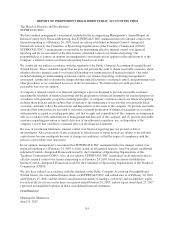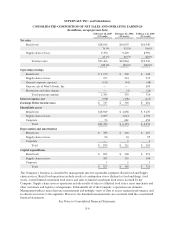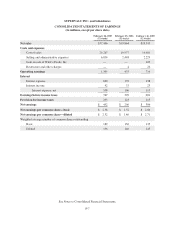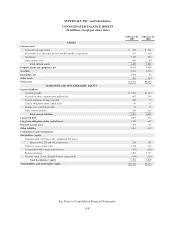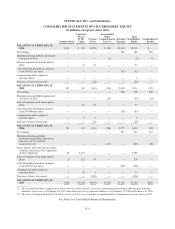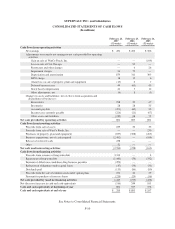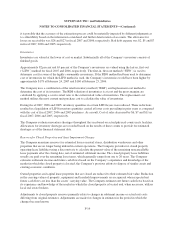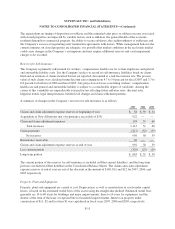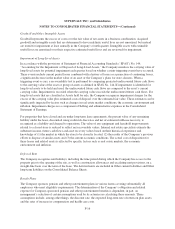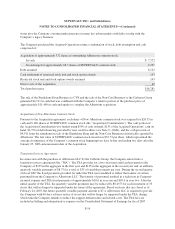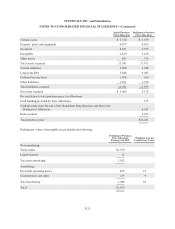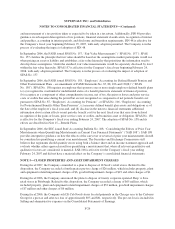Albertsons 2007 Annual Report Download - page 80
Download and view the complete annual report
Please find page 80 of the 2007 Albertsons annual report below. You can navigate through the pages in the report by either clicking on the pages listed below, or by using the keyword search tool below to find specific information within the annual report.SU
PERVAL
U
IN
C
. and
S
ubsidiaries
N
OTES TO CONSOLIDATED FINANCIAL STATEMENTS—(Continued)
it is possible that the accurac
y
of the estimation process could be materiall
y
impacted b
y
different
j
ud
g
ments as
to collectibility based on the information considered and further deterioration of accounts. The allowance for
l
osses on receivables was
$
28 and
$
27 in fiscal 2007 and 2006, respectively. Bad debt expense was
$
2,
$
5 and
$7
in fiscal 2007, 2006 and 200
5
, respectivel
y.
I
n
v
entor
i
es
I
nventories are valued at the lower of cost or market. Substantially all of the Company’s inventory consists of
fi
n
i
s
h
e
d
goo
d
s.
Approximately 82 percent and 6
5
percent of the Company’s inventories are valued using the last-in, first-ou
t
(
“LIFO”) method for fiscal 2007 and 200
6
, respectively. The first-in, first-out method (“FIFO”) is used t
o
d
etermine cost for some of the hi
g
hl
y
consumable inventories. If the FIFO method had been used to determin
e
cost of inventories for which the LIFO method is used, the Company’s inventories would have been higher b
y
a
pproximately
$
178 at February 24, 2007 and
$
160 at February 25, 2006
.
T
he Company uses a combination of the retail inventory method (“RIM”) and replacement cost method t
o
d
eterm
i
ne t
h
e cost o
fi
ts
i
nventory. T
h
e RIM va
l
uat
i
on o
fi
nventor
i
es
i
s at cost an
d
t
h
e gross marg
i
ns ar
e
calculated b
y
appl
y
in
g
a cost-to-retail ratio to the current retail value of inventories. The replacement cost
method utilizes the most current unit
p
urchase cost to calculate the value of inventories
.
Durin
g
fiscal 2007, 2006 and 200
5
, inventor
y
quantities in certain LIFO la
y
ers were reduced. These reductions
resulted in a liquidation of LIFO inventory quantities carried at lower costs prevailing in prior years as compare
d
w
ith the cost of fiscal 2007, 2006 and 2005 purchases. As a result, Cost of sales decreased by
$
6,
$
7 and
$
11 i
n
f
iscal 2007, 2006 and 200
5
, respectivel
y
.
Th
e Company eva
l
uates
i
nventory s
h
ortages t
h
roug
h
out t
h
e year
b
ase
d
on actua
l
p
h
ys
i
ca
l
counts
i
n
i
ts
f
ac
ili
t
i
es.
Allowances for inventor
y
shorta
g
es are recorded based on the results of these counts to provide for estimated
shortages as of the financial statement date
.
Reserves for C
l
ose
d
Properties an
d
Asset Impairment C
h
arge
s
Th
e Company ma
i
nta
i
ns reserves
f
or est
i
mate
dl
osses on reta
il
stores,
di
str
ib
ut
i
on ware
h
ouses an
d
ot
h
e
r
properties that are no lon
g
er bein
g
utilized in current operations. The Compan
y
provides for closed propert
y
o
perating lease liabilities using a discount rate to calculate the present value of the remaining noncancellable
l
ease payments a
f
ter t
h
ec
l
os
i
ng
d
ate, net o
f
est
i
mate
d
su
b
tenant
i
ncome. T
h
ec
l
ose
d
property
l
ease
li
a
bili
t
i
e
s
u
suall
y
are paid over the remainin
g
lease terms, which
g
enerall
y
ran
g
e from one to 26
y
ears. The Compan
y
estimates subtenant income and future cash flows based on the Company’s experience and knowledge of th
e
mar
k
et
i
nw
hi
c
h
t
h
ec
l
ose
d
property
i
s
l
ocate
d
,t
h
e Company’s prev
i
ous e
ff
orts to
di
spose o
f
s
i
m
il
ar assets an
d
existin
g
economic conditions
.
Owne
d
propert
i
es an
d
cap
i
ta
ll
ease propert
i
es t
h
at are c
l
ose
d
are re
d
uce
d
to t
h
e
i
r est
i
mate
df
a
i
rva
l
ue. Re
d
uct
i
o
n
in the carr
y
in
g
values of propert
y
, equipment and leasehold improvements are reco
g
nized when expected net
f
uture cash flows are less than the assets’ carrying value. The Company estimates net future cash flows based o
n
i
ts exper
i
ence an
dk
now
l
e
d
ge o
f
t
h
e mar
k
et
i
nw
hi
c
h
t
h
ec
l
ose
d
property
i
s
l
ocate
d
an
d
,w
h
en necessary, ut
ili
zes
l
ocal real estate brokers
.
A
dj
ustments to c
l
ose
d
property reserves pr
i
mar
il
yre
l
ate to c
h
anges
i
nsu
b
tenant
i
ncome or actua
l
ex
i
t cost
s
d
ifferin
g
from ori
g
inal estimates. Ad
j
ustments are made for chan
g
es in estimates in the period in which the
changes become known
.
F-
14



